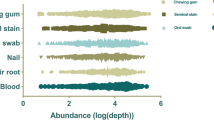Abstract
Single nucleotide polymorphisms (SNPs) have been widely used in forensics for prediction of identity, biogeographical ancestry (BGA) and externally visible characteristics (EVCs). Single base extension (SBE) assays, most notably SNaPshot® (Thermo Fisher Scientific), are commonly used for forensic SNP genotyping as they can be employed on standard instrumentation in forensic laboratories (e.g. capillary electrophoresis). High resolution melt (HRM) analysis is an alternative method and is a simple, fast, single tube assay for low throughput SNP typing. This study compares HRM and SNaPshot®. HRM produced reproducible and concordant genotypes at 500 pg, however, difficulties were encountered when genotyping SNPs with high GC content in flanking regions and differentiating variants of symmetrical SNPs. SNaPshot® was reproducible at 100 pg and is less dependent on SNP choice. HRM has a shorter processing time in comparison to SNaPshot®, avoids post PCR contamination risk and has potential as a screening tool for many forensic applications.




Similar content being viewed by others
References
Budowle B, van Daal A. Forensically relevant SNP classes. BioTechniques. 2008;44(5):603–10.
Kayser M, de Knijff P. Improving human forensics through advances in genetics, genomics and molecular biology. Nature Rev Genet. 2011;12(3):179–92.
Mehta B, Daniel R, Phillips C, McNevin D. Forensically relevant SNaPshot® assays for human DNA SNP analysis: a review. Int J Legal Med. 2017;131(1):21–37.
Sanchez JJ, Phillips C, Børsting C, Balogh K, Bogus M, Fondevila M, et al. A multiplex assay with 52 single nucleotide polymorphisms for human identification. Electrophoresis. 2006;27(9):1713–24.
Phillips C, Salas A, Sánchez JJ, Fondevila M, Gómez-Tato A, Álvarez-Dios J, et al. Inferring ancestral origin using a single multiplex assay of ancestry-informative marker SNPs. Forensic Sci Int Genet. 2007;1(3–4):273–80.
Walsh S, Liu F, Ballantyne KN, Oven MV, Lao O, Kayser M. IrisPlex: a sensitive DNA tool for accurate prediction of blue and brown eye colour in the absence of ancestry information. Forensic Sci Int Genet. 2011;5:170–80.
Mehta B, Daniel R, McNevin D. High resolution melting (HRM) of forensically informative SNPs. Forensic Sci Int Genet Supp Ser. 2013;4(1):e376–7.
Venables SJ, Mehta B, Daniel R, Walsh SJ, van Oorschot RAH, McNevin D. Assessment of high resolution melting analysis as a potential SNP genotyping technique in forensic casework. Electrophoresis. 2014;35(21–22):3036–43.
Reed GH, Kent JO, Wittwer CT. High resolution DNA melting analysis for simple and efficient molecular diagnostics. Pharmacogenomics. 2007;8(6):597–608.
Gundry CN, Vandersteen JG, Reed GH, Pryor RJ, Chen J, Wittwer CT. Amplicon melting analysis with labeled primers: a closed-tube method for differentiating homozygotes and heterozygotes. Clin Chem. 2003;49(3):396–406.
Liew M, Pryor R, Palais R, Meadows C, Erali M, Lyon E, et al. Genotyping of single-nucleotide polymorphisms by high-resolution melting of small amplicons. Clin Chem. 2004;50(7):1156–64.
Walsh S, Lindenbergh A, Zuniga SB, Sijenb T. Knijff Pd, Kayser M, et al. developmental validation of the IrisPlex system: determination of blue and brown iris colour for forensic intelligence. Forensic Sci Int Genet. 2011;5(5):464–71.
AppliedBiosystems. ABI PRISM® SNaPshot™ Multiplex Kit. P/N 4323357 Rev. B ed: Thermo Fisher Scientific. 2010;1–42.
Walsh S, Chaitanya L, Clarisse L, Wirken L, Draus-Barini J, Kovatsi L, et al. Developmental validation of the HIrisPlex system: DNA-based eye and hair colour prediction for forensic and anthropological usage. Forensic Sci Int Genet. 2014;9:150–61.
Westen AA, Matai AS, Laros JF, Meiland HC, Jasper M, de Leeuw WJ, et al. Tri-allelic SNP markers enable analysis of mixed and degraded DNA samples. Forensic Sci Int Genet. 2009;3(4):233–41.
Swen JJ, Baak-Pablo RF, Guchelaar H-J, van der Straaten T. Alternative methods to a TaqMan assay to detect a tri-allelic single nucleotide polymorphism rs757210 in the HNF1β gene. Clin Chem Lab Med. 2012;50(2):279–84.
Fondevila M, Phillips C, Santos C, Freire Aradas A, Vallone PM, Butler JM, et al. Revision of the SNPforID 34-plex forensic ancestry test: assay enhancements, standard reference sample genotypes and extended population studies. Forensic Sci Int Genet. 2013;7(1):63–74.
Seipp MT, Durtschi JD, Voelkerding KV, Wittwer CT. Multiplex amplicon genotyping by high-resolution melting. J Biomol Tech. 2009;20(3):160–4.
Nicklas JA, Buel E. Improving the efficiency of DNA casework analysis through simple, effective, PCR-based screening methods. NIJ Grant#2005-DA-BX-K003. 2011;1–115.
Derzelle S, Laroche S, Le Fleche P, Hauck Y, Thierry S, Vergnaud G, et al. Characterization of genetic diversity of bacillus anthracis in France by using high-resolution melting assays and multilocus variable-number tandem-repeat analysis. J Clin Microbiol. 2011;49(12):4286–92.
Bosmali I, Ganopoulos I, Madesis P, Tsaftaris A. Microsatellite and DNA-barcode regions typing combined with high resolution melting (HRM) analysis for food forensic uses: a case study on lentils (Lens culinaris). Food Res Int. 2012;46(1):141–7.
Ganopoulos I, Bazakos C, Madesis P, Kalaitzis P, Tsaftaris A. Barcode DNA high-resolution melting (bar-HRM) analysis as a novel close-tubed and accurate tool for olive oil forensic use. J Sci Food Agr. 2013;93(9):2281–6.
Malewski T, Draber-Mońko A, Pomorski J, Łoś M, Bogdanowicz W. Identification of forensically important blowfly species (Diptera: Calliphoridae) by high-resolution melting PCR analysis. Int J Legal Med. 2010;124(4):277–85.
Sijen T. Molecular approaches for forensic cell type identification: on mRNA, miRNA, DNA methylation and microbial markers. Forensic Sci Int Genet. 2015;18:21–32.
Acknowledgments
The authors gratefully acknowledge financial support from the Australian Research Council (LP110100121 - From genotype to phenotype: Molecular photofitting for criminal investigations).
Author information
Authors and Affiliations
Corresponding author
Ethics declarations
Ethics approval
All procedures performed in this study involving human participants were in accordance with the ethical standards of the University of Canberra Human Ethics Committee (Project number 11–19) and with the 1964 Helsinki declaration and its later amendments or comparable ethical standards.
Conflict of interest
The authors declare that they have no conflict of interest.
Rights and permissions
About this article
Cite this article
Mehta, B., Daniel, R. & McNevin, D. HRM and SNaPshot as alternative forensic SNP genotyping methods. Forensic Sci Med Pathol 13, 293–301 (2017). https://doi.org/10.1007/s12024-017-9874-5
Accepted:
Published:
Issue Date:
DOI: https://doi.org/10.1007/s12024-017-9874-5




